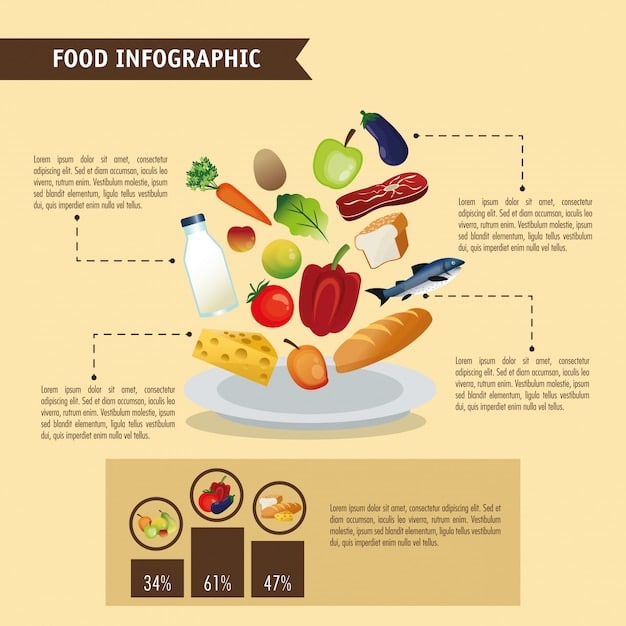USDA Dietary Guidelines 2025: Impact on Your Meal Plan

The new USDA Dietary Guidelines update for 2025 aims to provide Americans with the latest nutritional science, influencing meal planning by emphasizing personalized dietary patterns, focusing on food stage-based recommendations, and considering cultural diversity and equity in dietary advice.
Are you ready to revamp your meal plan for 2025? The USDA’s dietary guidelines are getting an update, and it’s time to understand how does the new USDA Dietary Guidelines update impact your 2025 meal plan? This update isn’t just about new rules; it’s about empowering you to make informed choices for a healthier lifestyle. Let’s dive in!
Understanding the USDA Dietary Guidelines
The USDA Dietary Guidelines serve as a cornerstone for nutritional advice in the United States. They are updated every five years to reflect the most current scientific evidence, ensuring that Americans receive the best possible guidance on food and nutrition.
What are the USDA Dietary Guidelines?
The USDA Dietary Guidelines provide recommendations on what to eat and drink to meet nutrient needs, promote health, and prevent chronic disease. These guidelines are designed to help individuals make informed food choices.
Who uses these guidelines?
These guidelines are used by a wide range of people, including healthcare professionals, nutrition educators, policymakers, and individuals looking to improve their diet.

The impact of these guidelines is far-reaching, influencing:
- Federal Nutrition Programs: Such as the National School Lunch Program and the Supplemental Nutrition Assistance Program (SNAP).
- Healthcare Recommendations: Providing a basis for doctors and dietitians to advise patients.
- Public Health Initiatives: Shaping campaigns aimed at improving the nation’s health.
Understanding the USDA Dietary Guidelines is crucial for anyone aiming to make healthier food choices and improve their overall well-being. They provide a science-based framework for creating a balanced and nutritious diet.
In summary, the USDA Dietary Guidelines are a vital resource for promoting health and preventing chronic diseases. They offer evidence-based recommendations that can help individuals make informed decisions about their diet.
Key Changes Expected in the 2025 Update
As we approach 2025, anticipation is building around the expected updates to the USDA Dietary Guidelines. While the official recommendations are yet to be released, experts are speculating on potential key changes that could significantly impact our meal plans.
Emphasis on Personalized Nutrition
One of the most anticipated changes is a greater emphasis on personalized nutrition. This approach recognizes that dietary needs vary based on individual factors such as age, sex, activity level, and health status.
Personalized nutrition might involve:
- Tailored Recommendations: Dietary advice that is specific to an individual’s unique needs and preferences.
- Genetic Testing: Using genetic information to guide dietary choices and optimize health outcomes.
- Digital Health Tools: Leveraging technology to track dietary intake and provide personalized feedback.
Focus on Food Stage-Based Recommendations
Another expected change is a greater focus on food stage-based recommendations, which means providing specific dietary guidance for different stages of life, from infancy to older adulthood.

These recommendations could include:
- Infant Nutrition: Guidelines on breastfeeding, formula feeding, and introducing solid foods.
- Childhood Nutrition: Recommendations for promoting healthy growth and development.
- Adult Nutrition: Advice on maintaining a healthy weight and preventing chronic diseases.
- Senior Nutrition: Guidance on meeting nutrient needs and supporting healthy aging.
These changes promise to make the dietary guidelines more relevant and effective for a wider range of individuals, promoting better health outcomes across the lifespan.
In conclusion, the 2025 USDA Dietary Guidelines update is expected to bring significant changes, with a greater emphasis on personalized nutrition and food stage-based recommendations. These changes will help individuals make more informed and effective choices for their health.
Impact on Different Food Groups
The USDA Dietary Guidelines play a crucial role in shaping recommendations for different food groups. Understanding how these guidelines influence each food group can help you make more informed choices when planning your meals.
Fruits and Vegetables
The guidelines typically emphasize the importance of consuming a wide variety of fruits and vegetables. These foods are rich in vitamins, minerals, and fiber, which are essential for overall health.
Recommendations often include:
- Increasing Intake: Encouraging people to eat more fruits and vegetables daily.
- Variety: Choosing a colorful array of fruits and vegetables to maximize nutrient intake.
- Preparation Methods: Suggesting healthy ways to prepare fruits and vegetables, such as steaming, roasting, or eating them raw.
Grains
The guidelines distinguish between whole grains and refined grains, recommending that at least half of your grain intake should come from whole grains. Whole grains provide more fiber and nutrients compared to refined grains.
Protein Foods
Protein foods are essential for building and repairing tissues, as well as supporting various bodily functions. The guidelines recommend choosing lean protein sources, such as poultry, fish, beans, and nuts.
The guidelines typically suggest:
- Lean Choices: Opting for lean cuts of meat, skinless poultry, and fish.
- Plant-Based Proteins: Incorporating more plant-based protein sources, such as beans, lentils, and tofu.
- Limiting Processed Meats: Reducing the consumption of processed meats, which are often high in sodium and saturated fat.
By understanding how the USDA Dietary Guidelines impact different food groups, you can make more informed choices when planning your meals. These guidelines provide a framework for creating a balanced and nutritious diet that supports overall health.
In summary, the USDA Dietary Guidelines offer valuable recommendations for different food groups, helping individuals make healthier choices. By focusing on fruits, vegetables, whole grains, lean proteins, and healthy fats, you can create a well-rounded and nutritious meal plan.
Planning Your 2025 Meals
With the anticipated updates to the USDA Dietary Guidelines in 2025, now is the perfect time to start planning your meals accordingly. Incorporating these guidelines into your daily diet can help you achieve better health and well-being.
Assessing Your Current Diet
Before making any changes, it’s important to assess your current diet. This involves tracking what you eat and drink over a period of time to identify areas where you can improve.
Consider the following:
- Food Journal: Keep a detailed record of everything you eat and drink, including portion sizes and preparation methods.
- Nutrient Analysis: Use online tools or consult a registered dietitian to analyze your nutrient intake and identify any deficiencies or excesses.
- Habit Evaluation: Reflect on your eating habits and identify any patterns or triggers that lead to unhealthy choices.
Setting Realistic Goals
Once you have a clear understanding of your current diet, it’s time to set realistic goals. Start with small, achievable changes that you can gradually build upon.
Examples of realistic goals include:
- Increasing Fruit and Vegetable Intake: Aim to eat at least five servings of fruits and vegetables each day.
- Switching to Whole Grains: Replace refined grains with whole grains whenever possible.
- Choosing Lean Proteins: Opt for lean protein sources such as poultry, fish, beans, and nuts.
Creating a Meal Plan
A well-structured meal plan can help you stay on track and make healthier choices. Plan your meals in advance, considering the USDA Dietary Guidelines and your personal preferences.
Creating a meal plan involves:
- Selecting Nutritious Recipes: Choose recipes that are based on whole, unprocessed foods and align with the dietary guidelines.
- Planning Your Meals: Determine what you will eat for breakfast, lunch, dinner, and snacks each day.
- Preparing Your Food: Cook your meals at home whenever possible to control ingredients and portion sizes.
By assessing your current diet, setting realistic goals, and creating a meal plan, you can successfully incorporate the USDA Dietary Guidelines into your daily routine and achieve better health outcomes.
In summary, planning your 2025 meals involves assessing your current diet, setting realistic goals, and creating a well-structured meal plan. By following these steps, you can make healthier choices and improve your overall well-being.
Addressing Common Concerns
As with any dietary guidelines update, there are often concerns and questions that arise. Addressing these common concerns can help you better understand and implement the recommendations in your meal plan.
Cost of Healthy Eating
One of the most common concerns is the cost of healthy eating. Many people believe that eating nutritious foods is more expensive than eating processed or fast foods. While this can be true in some cases, there are ways to eat healthy on a budget.
Time Constraints
Another common concern is time constraints. Many people feel that they don’t have enough time to plan, shop for, and prepare healthy meals.
Managing limited time involves:
- Meal Prepping: Dedicate a few hours each week to prepare meals in advance.
- Simple Recipes: Choose recipes that are quick and easy to make.
- Convenient Options: Utilize convenient healthy options, such as pre-cut vegetables and canned beans.
Dietary Restrictions
Dietary restrictions, such as allergies or intolerances, can make it challenging to follow the USDA Dietary Guidelines.
Accommodating dietary restrictions involves:
- Substitutions: Find suitable substitutions for foods you cannot eat.
- Label Reading: Carefully read food labels to identify potential allergens or ingredients to avoid.
- Professional Guidance: Consult a registered dietitian or healthcare professional for personalized advice.
By addressing these common concerns, you can overcome potential barriers to healthy eating and successfully implement the USDA Dietary Guidelines in your meal plan. With proper planning and resourcefulness, you can enjoy a nutritious and satisfying diet that supports your health goals.
In summary, addressing common concerns such as the cost of healthy eating, time constraints, and dietary restrictions is essential for successfully implementing the USDA Dietary Guidelines. By finding practical solutions and seeking professional guidance, you can overcome these challenges and enjoy a healthier diet.
Monitoring Your Progress
Once you’ve implemented the updated USDA Dietary Guidelines into your 2025 meal plan, it’s important to monitor your progress. Tracking your dietary habits and health outcomes can help you stay motivated and make necessary adjustments along the way.
Tracking Your Food Intake
Keeping track of your food intake is a crucial step in monitoring your progress. This involves recording what you eat and drink each day, as well as noting portion sizes and preparation methods.
Regular Health Check-Ups
Regular health check-ups are essential for monitoring your overall health and identifying any potential issues early on.
| Key Point | Brief Description |
|---|---|
| 🍎 Focus on Fruits & Veggies | Prioritize a colorful variety of fruits and vegetables in your daily meals. |
| 🌾 Whole Grains Over Refined | Choose whole grains like brown rice and oats instead of refined grains. |
| 🍗 Lean Proteins | Include lean protein sources such as poultry, fish, beans, and nuts in your diet. |
| 💧 Stay Hydrated | Drink plenty of water throughout the day to stay hydrated and support overall health. |
FAQ: USDA Dietary Guidelines 2025
▼
The primary goals include promoting overall health, preventing chronic diseases, and providing updated nutritional recommendations based on the latest scientific evidence. They aim to help Americans make informed food choices.
▼
The USDA Dietary Guidelines are updated every five years to incorporate new scientific findings and ensure that the recommendations reflect the most current understanding of nutrition and health.
▼
Possible changes include a greater emphasis on personalized nutrition, recommendations tailored to different life stages, and a focus on cultural diversity and equity in dietary advice to enhance relevance and effectiveness.
▼
Strategies include buying seasonal produce, purchasing in bulk, planning meals ahead, and exploring cost-effective protein sources, such as beans and lentils, to maintain a nutritious diet on a budget.
▼
You can find detailed information on the USDA website, including the full guidelines, supporting materials, and educational resources. Additionally, consulting a registered dietitian can provide personalized guidance.
Conclusion
In conclusion, understanding how does the new USDA Dietary Guidelines update impact your 2025 meal plan is pivotal for maintaining a healthy lifestyle. By focusing on personalized nutrition, incorporating diverse food groups, and monitoring your progress, you can make informed choices that align with the latest scientific evidence and support your overall well-being. Stay proactive, stay informed, and embrace the opportunity to enhance your health through mindful eating.





